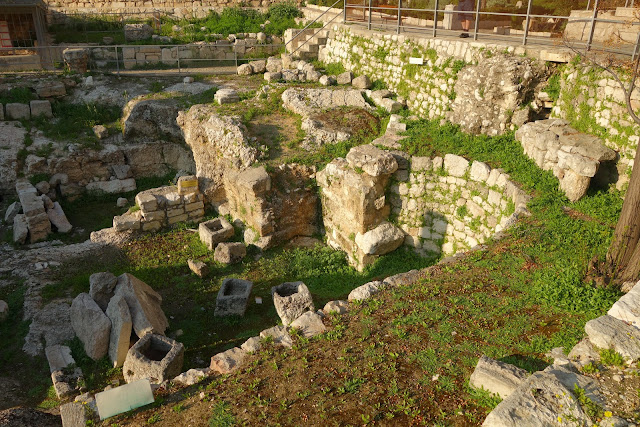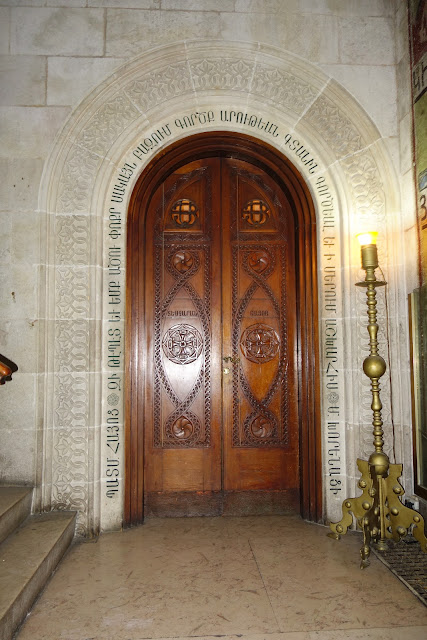Up to this point, everything had been interesting and amazing, but for me, this was the day the journey felt less like a historical experience and more like a spiritual experience.
These are ancient Arab walls, with bricked-in doorways.
Perhaps this explains why those doors are permanently closed, but I forgot my reading glasses.
Along these walls is the Lion's Gate or Sheep Gate. Look closely and you can see the lions on either side, near the top of the arch. Our guide said these are actually panthers, not lions, and this gate gets its name from the fact that panthers and lambs were driven through here on their way to be sacrificed in the temple. It is also the way Christ would have come on his way to be crucified.
A typical Muslim women, on the way home from prayer.
We came through these doorways into
the area of the pool of Bethesda.
The lovely courtyard inside the gate reminded me somehow of SLC temple square, with its beautiful flower beds. That could almost be a bust of Brigham Young, but its Cardinal Lavigerie.
Inside this area is the Church of St. Anne, a Catholic church. Built sometime around 1131, over an Byzantine basilica. This is believed to be the spot of the home of Anna and Joachim and birthplace of Mary, mother of Jesus.
The pool of Bethesda is ahead.
St Anne's is simple, but full of the unexpected.
The inside was surprisingly small, with a high, domed ceiling.
We found the religious leaders in Jerusalem to be friendly, gracious, welcoming, and tolerant. The priest at St. Anne's was not exception. After a short conversation to see if we were a group, he invited us to sing,
Julia and Judy with the Priest
and sing we did (I Am a Child of God). We didn't know when we started that this church is known for its incredible acoustics. Our little group sounded shockingly amazing, if I do say so myself. Too bad we can't replicate those acoustics for ward choirs everywhere.
So often we see Christ as a child with his mother, but I loved seeing this depiction of Mary and her mother.
This stairway was open, but sadly, we didn't go down. If we had, we would have seen the ancient remains of the home of Mary's parents.
Note the thick walls.
Crosses in this part of the world are square-ish.
The Pool of Bethesda was a place people often gathered to use its healing power. This is the place Christ healed the man who had been crippled for 38 years. Michael Wilcox gave another of his wonderful discourses about how some blessings don't come immediately, and need patience and faith in the Lord's timing.
It was easy to imagine the Savior here in this quiet place, without fanfare or ego, healing someone who was in need, and the joy of the crippled man, now healed.
In the 19th century, this site experienced an archaeological dig, and those in the know realized it indeed matched the biblical account, as well as traditional beliefs that this was "the place".
The Pool of Bethesda was a beautiful area, peaceful and quiet the day we visited.
It's incredible to think how old these walls are.
We left the Pool and headed down ancient roads with modern graffiti.
This Roman pavement dates back to the time of Christ.
Another example of the clever ramps and stairs.
We passed the Northern Gallery, a medieval cellar tucked into the Roman pavement. We didn't go in, there's only so much time to see way too much.
I want the guy who installed this floor to redo my bathroom. Too bad he's been gone for 2000 years or so.
This area is know as the "Via Dolorosa", the path Christ walked, carrying his cross, on the way to His crucifixion. There above the arch, you can see a depiction of Christ and his mother, Mary.
Along the way are 9 Stations of the Cross, with 4 or 5 more inside the church. The stations are revered by various Christian groups as a way remember and worship the Savior.
There are also markets in this area, full of trinkets you didn't know you needed, sold by people who are going to give you a special deal because they like you so much. They may even turn to your husband and tell him to "buy this for your daughter", meaning me. Yep, they've got their selling skills honed.
I saw this from the distance and thought it was gelato, but alas, it was only dyed florescent vegetables. Hmmm, I think I'll pass.
Piles of garbage are everywhere in this part of the world. Considering the sacred history of this place, these piles everywhere seem so incongruous. Our guide explained that culturally, clean streets are not important to the locals.
This is the entrance to the market.
But we were on the way to the Church of the Holy Sepulchre.
This beautiful church is believed by many Christians to be the site of the crucifixion, burial, and resurrection of Christ.
This church was built around 325 by the first Christian emperor, Constantine.
Through the centuries, it has endured the typical fires, earthquakes, and destructive invaders.
The church was rebuilt and added to numerous times, including the most recent addition, a dome in 1870. There were originally two doorways, but as you can see, one has been bricked up. These people have a passion for bricking up doorways.
Currently, it's headquarters of Greek Orthodox, as well as home to Eastern Orthodoxy, Oriental Orthodoxy, and Roman Catholicism.
Protestants tend to believe the events of Christ's death and resurrection happened elsewhere.
At first the extreme ornamental features of the church were distracting and off-putting,
but as I watch individuals and families worship, that impression was replaced by a feeling of respect and reverence. One of the first places we saw as we entered was this "Stone of Unction". where Christ's body was prepared for burial. Worshippers knelt, kissed or laid their face on it while they prayed. There were lots of people waiting their turn--it was a popular spot. I felt disrespectful taking pictures here, but I watched as several moms, dads, and kids knelt together here in worship. How can you not be touched by that sight?
Next we saw a group of young men singing/chanting/preaching. These young men could almost have been Mormon missionaries with their dark clothing and worshipful, clean-cut appearance.
There were several beautiful mosaics in the church, like this one.
I kinda love the colorful and distinctive clothing worn by the leaders.
In the center of the rotundra was the Sepulchre, the tomb of Christ. We stood in a (long) line, and were allowed to enter for thirty seconds or so, in groups of two or three.
Opposite the tomb was this chapel-type space.
The view of the top of the dome.
This dome is surrounded by 12 rays, representing the apostles.
The tomb of Christ was encased in steel beams, whether for protection or stability, I'm not sure.
Waiting for our turn to go into the tomb. We were not allowed to take pictures inside.
This picture is from holylandphotos.org of the inside of the tomb area. The tomb has been encased in marble to protect it from all the touching it endures.

A lovely door in the church.
An old door in the church.
I was intrigued by the variety of people who came to worship at the Stone of Unction.
On the wall behind the stone was this mural, depicting the removal of Christ's body from the cross, the preparation of the body, and the burial.
Close-up of the above scenes.
I love the facial expressions on this one.
Everywhere I looked, there were intricate mosaics or
colorful chandeliers,
or gilded surfaces.
and tourists intermingled with worshippers.
The day we were there, a leader from the Greek Orthodox church was visiting.
There was a rather long meeting involved. A local woman told me who he was and that she considered it "a big deal" to have such an important visitor.
Another dome. This one looked like you could walk in the area around the columns, but the stairway was closed off.
Outside of the church, live goes on.
The church in the evening light.
We headed back to the market, now mostly closed.
The headache method of carrying your belongings.
We stopped at the "Families Restaurant"
which clearly catered to both Americans
and non-Americans.
I quickly discovered the best part of the meal was the first part with salad-y and humus dishes.
Israel loves lamb. I don't. I won't be visiting this part of the world again to enjoy the food.
We had a couple of really, really good meals. This wasn't one of them. However, Stan stuck up a conversation with our Arab waiter, who wasn't at all impressed by our six kids. He said, "But can you top five children in two years?" Turns out he had identical triple boys,
followed by fraternal twin girls.
When Judy asked if his wife had help, he looked surprised and told us that basically, his amazing wife could do anything. I found the Muslim men talked very highly and affectionately about their wife and children. I like that.
We had been warned that this trash-filled exit had a pick-pocket problem. We returned to the market another day, and that second time as we left, I was walking with Judy ahead of Bob and Stan. I heard a kerfuffle behind us and turned to see a local yelling and waving his arms around. I thought nothing of it, but learned the next day that Stan had caught the guy with his hand in his pocket. Stan managed to interrupt his mission, and the guy jumped back, yelling and waving his arms about as if STAN were the one causing problems.
It was another lovely, amazing day, a day I just KNEW we wouldn't top. We did.
View from our hotel room.

















































































We weren't allowed to take pictures in the sepulchre, but STAN took one. (With flash, according to Bob.) I want to see it! Did it turn out? He's lucky the priests didn't conk his head with one of those stones. I agree that it was very moving to see the worship going on. I have a lot of respect for that kind of heart-felt devotion.
ReplyDeleteI haven't seen the picture. I can't get Stan to find the time to send it to me. If he ever does, I'm just going to make a few adjustments to this post.
DeleteLet us know when you do. We will call Stan too say our final goodbyes.
DeleteYes, where is the contraband Sepulchre photo. I was standing next to Stan the Man when he defiled the Holy Sepulchre. With all of the guys with hoods, I imagined an axe and my head laid upon a stone to have it removed.
ReplyDeleteIt is interesting how thick the walls are on all the buildings.
ReplyDelete